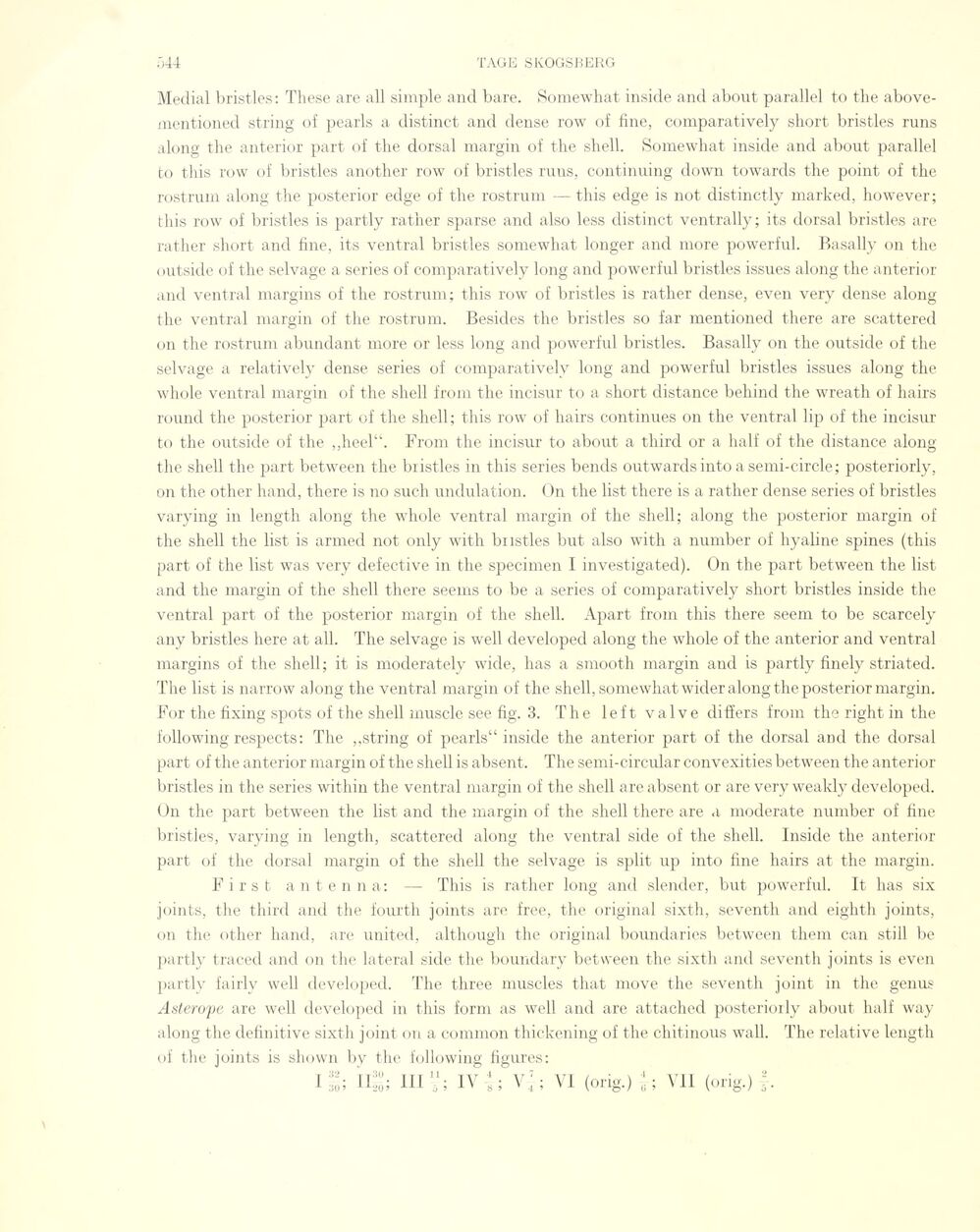
Full resolution (JPEG) - On this page / på denna sida - Sidor ...

<< prev. page << föreg. sida << >> nästa sida >> next page >>
Below is the raw OCR text
from the above scanned image.
Do you see an error? Proofread the page now!
Här nedan syns maskintolkade texten från faksimilbilden ovan.
Ser du något fel? Korrekturläs sidan nu!
This page has never been proofread. / Denna sida har aldrig korrekturlästs.
Medial V)ristles : These are all simple and bare. Somewhat inside and about parallel to the
above-mentioned string oi pearls a distinct and dense row of fine, comparatively short bristles runs
along the anterior part of the dorsal margin of the shell. Somewhat inside and about parallel
to this row of bristles another row of bristles runs, continuing down towards the point of the
rostrum along the posterior edge of the rostrum —this edge is not distinctly marked, however;
this row of bristles is partly rather sparse and also less distinet ventrally; its dorsal bristles are
rather short and fine, its ventral bristles somewhat longer and more powerful. Basally on the
outside of the selvage a series of comparatively long and powerful bristles issues along the anterior
and ventral margins of the rostrum; this row of bristles is rather dense, even very dense along
the ventral margin of the rostrum. Besides the bristles so far mentioned there are scattered
on the rostrum abundant more or less long and powerful bristles. Basally on the outside of the
selvage a relatively dense series of comparatively long and powerful bristles issues along the
whole ventral margin of the shell from the incisur to a short distance behind the wreath of hairs
round the posterior part of the shell; this row of hairs continues on the ventral lip of the incisur
to the outside of the ,,heel“. From the incisur to about a third or a half of the distance along
the shell the part between the biistles in this series bends outwardsinto a semi-circle; posteriorly,
on the other hand, there is no such undulation. On the list there is a rather dense series of bristles
varying in length along the whole ventral margin of the shell; along the posterior margin of
the shell the list is armed not only with biistles but also with a number of hyaline spines (this
part of the list was very defective in the specimen I investigated). On the part between the list
and the margin of the shell there seems to be a series of comparatively short bristles inside the
ventral part of the posterior margin of the shell. Apart from this there seem to be scarcely
any bristles here at all. The selvage is well developed along the whole of the anterior and ventral
margins of the shell; it is moderately wide, has a smooth margin and is partly finely striated.
The list is narrow along the ventral margin of the shell, somewhat wider along the posterior margin.
For the fixing spots of the shell muscle see fig. 3. The left valve differs from the right in the
following respects : The „string of pearls“ inside the anterior part of the dorsal and the dorsal
part of the anterior margin of the shell is absent. The semi-circular convexities between the anterior
bristles in the series within the ventral margin of the shell are absent or are very weakly developed.
On the part between the list and the margin of the shell there are a moderate number of fine
bristles, varying in length, scattered along the ventral side of the shell. Inside the anterior
part of the dorsal margin of the shell the selvage is split up into fine hairs at the margin.
First antenna: — This is rather long and siender, but powerful. It has six
joints, the third and the fourth joints are free, the original sixth, seventh and eighth joints,
on the other hand, are united, although the original boundaries between them can still be
partly traced and on the lateral side the boundary between the sixth and seventh joints is even
partly fairly well developed. The three muscles that move the seventh joint in the genus
Asteropa are well developed in this form as well and are attached posteriorly about half way
along the definitive sixth joint on a common thickening of the chitinous wall. The relative length
of the joints is shown by the following figures:
1 ll%i lit “; IV : ; V-J ; VI (orig.) J ; Vil (orig.) :.
<< prev. page << föreg. sida << >> nästa sida >> next page >>